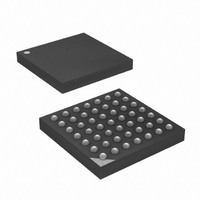ATXMEGA16A4-CUR Atmel, ATXMEGA16A4-CUR Datasheet - Page 362

ATXMEGA16A4-CUR
Manufacturer Part Number
ATXMEGA16A4-CUR
Description
MCU AVR 16+4KB FLASH 49VFBGA
Manufacturer
Atmel
Series
AVR® XMEGAr
Specifications of ATXMEGA16A4-CUR
Core Processor
AVR
Core Size
8/16-Bit
Speed
32MHz
Connectivity
I²C, IrDA, SPI, UART/USART
Peripherals
Brown-out Detect/Reset, DMA, POR, PWM, WDT
Number Of I /o
34
Program Memory Size
16KB (8K x 16)
Program Memory Type
FLASH
Eeprom Size
1K x 8
Ram Size
2K x 8
Voltage - Supply (vcc/vdd)
1.6 V ~ 3.6 V
Data Converters
A/D 12x12b, D/A 2x12b
Oscillator Type
Internal
Operating Temperature
-40°C ~ 85°C
Package / Case
49-VFBGA
For Use With
ATAVRONEKIT - KIT AVR/AVR32 DEBUGGER/PROGRMMRATSTK600 - DEV KIT FOR AVR/AVR32770-1007 - ISP 4PORT ATMEL AVR MCU SPI/JTAG770-1004 - ISP 4PORT FOR ATMEL AVR MCU SPI
Lead Free Status / RoHS Status
Lead free / RoHS Compliant
Available stocks
Company
Part Number
Manufacturer
Quantity
Price
- Current page: 362 of 445
- Download datasheet (6Mb)
30. Memory Programming
30.1
30.2
8077H–AVR–12/09
Features
Overview
•
•
•
•
•
•
•
This section describes how to program the Non Volatile Memory (NVM) in XMEGA, and covers
both self-programming and external programming. The NVM consist of the Flash Program Mem-
ory, User Signature and Calibration rows, Fuses and Lock Bits, and EEPROM data memory. For
details on the actual memories, how they are organized and the register description for the NVM
Controller used to access the memories, refer to
The NVM can be accessed for read and write both from application software through self-pro-
gramming and from an external programmer. For both external programming and self-
programming access to the NVM is done through the common NVM Controller, and the two
methods of programming are very similar. Memory access is done by loading address and/or
data into the NVM, and a set of commands and triggers that make the NVM Controller perform
specific tasks on the NVM.
From external programming all memory spaces can be read and written, expect for the Calibra-
tion Row which can only be read. The device can be programmed in-system and is accessed
through the PDI using the PDI or JTAG physical interfaces,
379
Self-programming and Boot Loader support allows application software in the device to read and
write the Flash, User Signature Row and EEPROM, write the Lock Bits to a more secure setting,
and read the Calibration Row and Fuses. The Flash allows Read-While-Write self-programming
meaning that the CPU can continue to operate and execute code while the Flash is being pro-
grammed.
Read and Write access to all memory spaces from
Self-Programming and Boot Loader Support
External Programming
High Security with Separate Boot Lock Bits for
Reset Fuse to Select Reset Vector address to the start of the
Code Efficient Algorithm
Efficient Read-Modify-Write Support
– External programmers
– Application Software
– Real Read-While-Write Self-Programming
– The CPU can run and execute code while Flash is being programmed
– Any communication interface can be used for program upload/download
– Support for in-system and production programming
– Programming through serial PDI or JTAG interface
– Fast and reliable interfaces.
– External programming access
– Boot Loader Section access
– Application Section access
– Application Table access
– Application Section, or
– Boot Loader Section
describes PDI and JTAG in detail.
”Self-Programming and Boot Loader Support” on page 367
”Memories” on page
”External Programming” on page
18.
describes this in detail.
XMEGA A
362
Related parts for ATXMEGA16A4-CUR
Image
Part Number
Description
Manufacturer
Datasheet
Request
R

Part Number:
Description:
DEV KIT FOR AVR/AVR32
Manufacturer:
Atmel
Datasheet:

Part Number:
Description:
INTERVAL AND WIPE/WASH WIPER CONTROL IC WITH DELAY
Manufacturer:
ATMEL Corporation
Datasheet:

Part Number:
Description:
Low-Voltage Voice-Switched IC for Hands-Free Operation
Manufacturer:
ATMEL Corporation
Datasheet:

Part Number:
Description:
MONOLITHIC INTEGRATED FEATUREPHONE CIRCUIT
Manufacturer:
ATMEL Corporation
Datasheet:

Part Number:
Description:
AM-FM Receiver IC U4255BM-M
Manufacturer:
ATMEL Corporation
Datasheet:

Part Number:
Description:
Monolithic Integrated Feature Phone Circuit
Manufacturer:
ATMEL Corporation
Datasheet:

Part Number:
Description:
Multistandard Video-IF and Quasi Parallel Sound Processing
Manufacturer:
ATMEL Corporation
Datasheet:

Part Number:
Description:
High-performance EE PLD
Manufacturer:
ATMEL Corporation
Datasheet:

Part Number:
Description:
8-bit Flash Microcontroller
Manufacturer:
ATMEL Corporation
Datasheet:

Part Number:
Description:
2-Wire Serial EEPROM
Manufacturer:
ATMEL Corporation
Datasheet:











